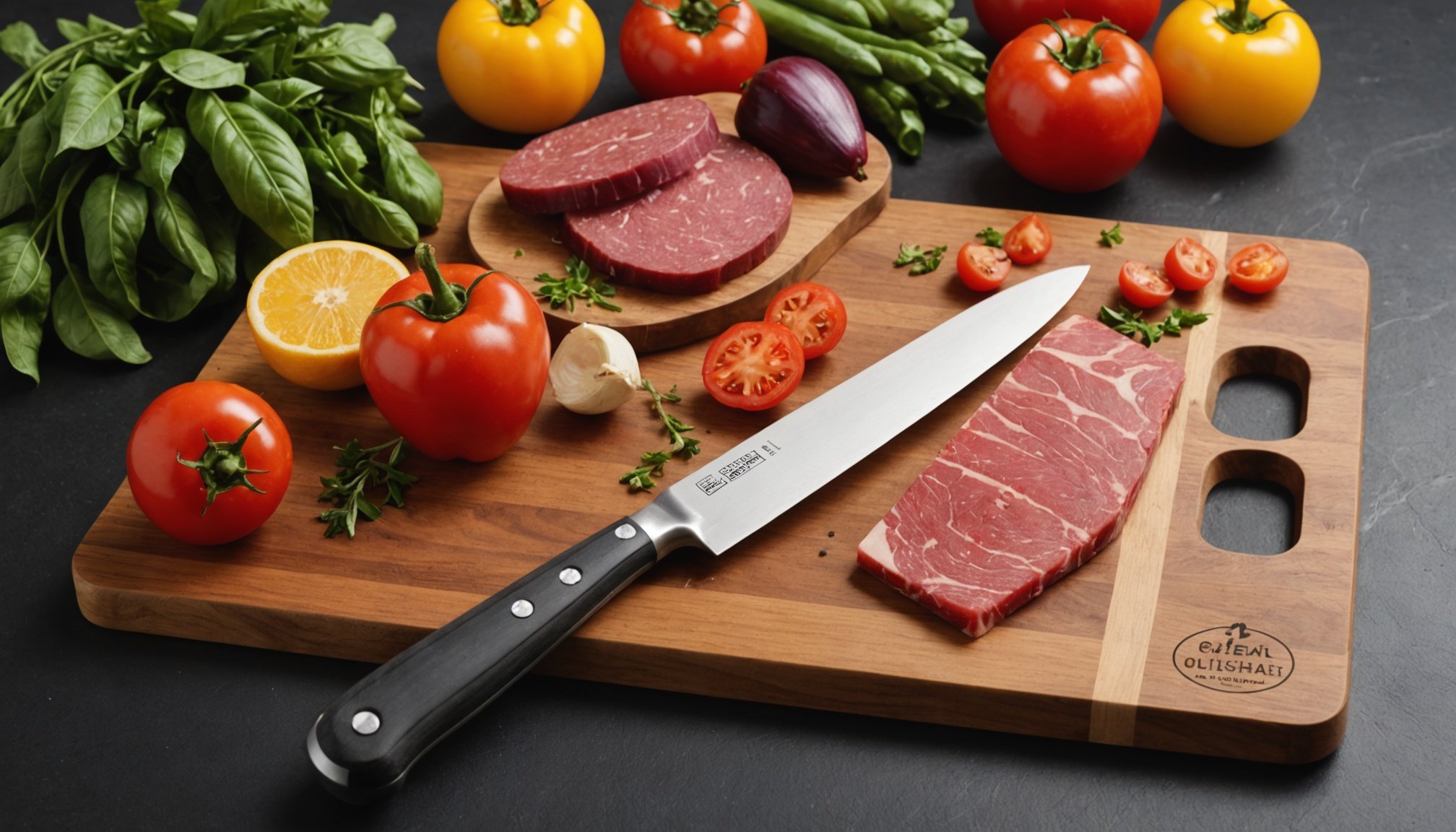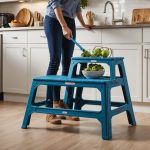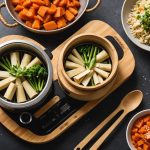Overview of Chopping Boards
Chopping boards are essential culinary tools found in every kitchen. They serve as the foundation for meal preparation, allowing for safe and convenient cutting of ingredients. The right chopping board not only enhances cooking efficiency but also contributes to kitchen safety and hygiene.
There are various chopping board types available, each with unique characteristics suited to specific tasks. The most common materials used include wood, plastic, and bamboo. Wooden chopping boards, often preferred for their durability and aesthetics, provide an ideal surface for cutting vegetables and meats. Plastic boards are lightweight, providing convenient and hygienic options for handling raw poultry or seafood. Meanwhile, bamboo boards offer a sustainable choice, possessing qualities that sit between wood and plastic in terms of care and versatility.
This might interest you : The definitive handbook for selecting perfect rustic kitchen curtains for your uk home
Choosing the right chopping board involves evaluating its intended use in the kitchen essentials context. Consider factors like durability, ease of cleaning, and the impact on knife edges. By selecting the appropriate board for specific culinary tasks—vegetable prep versus meat cutting, for instance—you can maintain both the board’s and your knife’s longevity. This not only supports the functionality of your other culinary tools but also enhances overall cooking enjoyment.
Types of Chopping Boards
Selecting the appropriate chopping board is vital to fulfilling diverse tasks in the kitchen efficiently. Understanding the distinct types offered is essential for any culinary enthusiast.
Topic to read : Expert tips for mastering humidity control in uk kitchen pantries
Wooden Chopping Boards
Wood chopping boards stand out for their durability and aesthetic appeal. They are perfect for prepping vegetables and meats due to their softness, which preserves knife edges while providing a solid cutting surface. Wooden boards require regular maintenance, like oiling, to extend their life and avoid warping. Proper care ensures longevity and reduces bacterial growth, maintaining both the board’s appearance and functionality over time.
Plastic Chopping Boards
Plastic chopping boards are praised for their lightweight and hygienic properties. They often find their place in kitchens for handling raw poultry and seafood. These boards offer easy cleaning, often being dishwasher-safe. However, they can dull knives quickly and may need replacement more frequently than wooden boards. Regular sanitization helps address hygiene concerns effectively.
Bamboo Chopping Boards
Bamboo chopping boards are renowned for being an environmentally sustainable choice. They strike a balance between the sturdiness of wood and the ease of plastic. Not only are they eco-friendly, but bamboo is also resistant to knife scarring, making it a hygienic option. The sourcing ethics of bamboo contribute to their appeal, promoting environmentally conscious choices in kitchen essentials.
Maintenance and Care
Proper maintenance and care are crucial to ensure the longevity and hygiene of chopping boards, a staple in any culinary setting.
Cleaning Practices
Chopping board cleaning routines vary by material. For wood, hand wash with mild soap and warm water, avoiding soaking to prevent warping. A mixture of white vinegar and water can be used periodically for sanitization. Plastic boards offer convenience, often being dishwasher-safe—ensure a hot water cycle for best results. For bamboo, avoid prolonged water exposure; instead, wipe with a damp cloth and use a mild detergent if needed. Regular cleaning is a key aspect of board hygiene, removing food residues and minimizing odor transfer.
Longevity Tips
To preserve your board’s surface and maintain knife edge preservation, periodic oiling is essential for wood and bamboo boards. Use mineral oil to keep moisture out and prevent cracking. Store boards upright in a dry area to avoid moisture build-up, and keep away from direct sunlight. Remember, treating boards with care helps extend their life significantly.
Avoid common mistakes like using harsh abrasives or chemicals that can damage the surface. Integrating these practices not only supports the integrity of chopping boards but also enhances their functionality in the kitchen.
Addressing Common Concerns
Navigating the array of available chopping boards entails understanding key issues like hygiene concerns, durability, and the impact of ethical sourcing.
Chopping board hygiene is a frequent concern for users. Wood and bamboo boards possess natural antimicrobial properties, reducing bacterial growth. However, maintaining hygiene requires regular oiling and cleaning with mild soap. Plastic boards, while less demanding in terms of maintenance, can trap scratches where bacteria may hide, necessitating thorough sanitization after each use.
When evaluating durability issues, consider how board material affects longevity. Wooden boards, though requiring consistent care, are robust and less damaging to knives. Plastic boards may offer convenience but tend to wear more quickly. Bamboo strikes a balance, being both sustainable and resistant to knife scars.
Ethical sourcing plays a significant role in consumer choices, particularly for environmentally conscious buyers. Bamboo boards stand out due to their rapid growth and renewable nature, offering a guilt-free addition to kitchen essentials. Opting for ethically sourced wood, which supports sustainable forestry practices, aligns with a commitment to environmental responsibility, ensuring your culinary tools contribute to a healthier planet.
Recommendations and Buying Guide
Choosing the best chopping boards is crucial to enhance your culinary experience and maintain your kitchen’s efficiency. This guide highlights top recommendations based on quality, practicality, and user satisfaction, aiding you in making informed kitchen buys.
Top Picks for Wooden Chopping Boards
When looking for wooden boards, consider those praised for their durability and aesthetic appeal. They are ideal for preserving knife edges and are perfect for prepping vegetables and meats. Brands offering a balance between budget options and high-end selections with robust features are recommended. Look for boards requiring minimal maintenance yet providing long-lasting use. Customers often appreciate boards with a well-crafted finish and ample size options, boosting functionality.
Top Picks for Plastic Chopping Boards
Plastic boards are favored for their hygienic properties and ease of care. User favorites typically boast a balance of size, thickness, and durability, ensuring convenient use and easy cleaning. Go for reputable brands offering warranties and sustainable materials, ensuring you receive a board that withstands regular use while catering to various kitchen tasks.
Top Picks for Bamboo Chopping Boards
For eco-conscious buyers, bamboo chopping boards shine in terms of sustainability and practicality. These boards should be evaluated for features like environmental friendliness, durability, and ease of use. Look for brands celebrated for ethical sourcing practices, offering boards that provide excellent performance while remaining environmentally responsible.
Selecting the Right Chopping Board
Choosing the correct chopping board greatly influences your culinary experience. It’s imperative to assess certain factors before making a decision. Firstly, consider the board’s material. Wooden boards are excellent for those prioritizing knife edge preservation and aesthetics. In contrast, plastic chopping boards offer lightweight versatility ideal for rigorous use, while bamboo boards provide a sustainable option for the eco-conscious.
When you select a board, you’re choosing more than just a kitchen essential; think about matching the board type to your distinct culinary needs. For example, the board used for vegetarian dishes might vary from the one best suited for preparing raw meats. Matching the board type to your specific culinary tasks can significantly reduce wear and tear on both the tools and board itself.
Balancing aspects such as durability and functionality against aesthetics is crucial. Bamboo offers resilience and sustainability, while plastic demands regular replacement yet excels in hygiene. Wooden boards strike a balance with their enduring nature. By thoughtfully considering these elements, you enhance not just your cooking efficiency but also the overall enjoyment of your kitchen endeavours.










